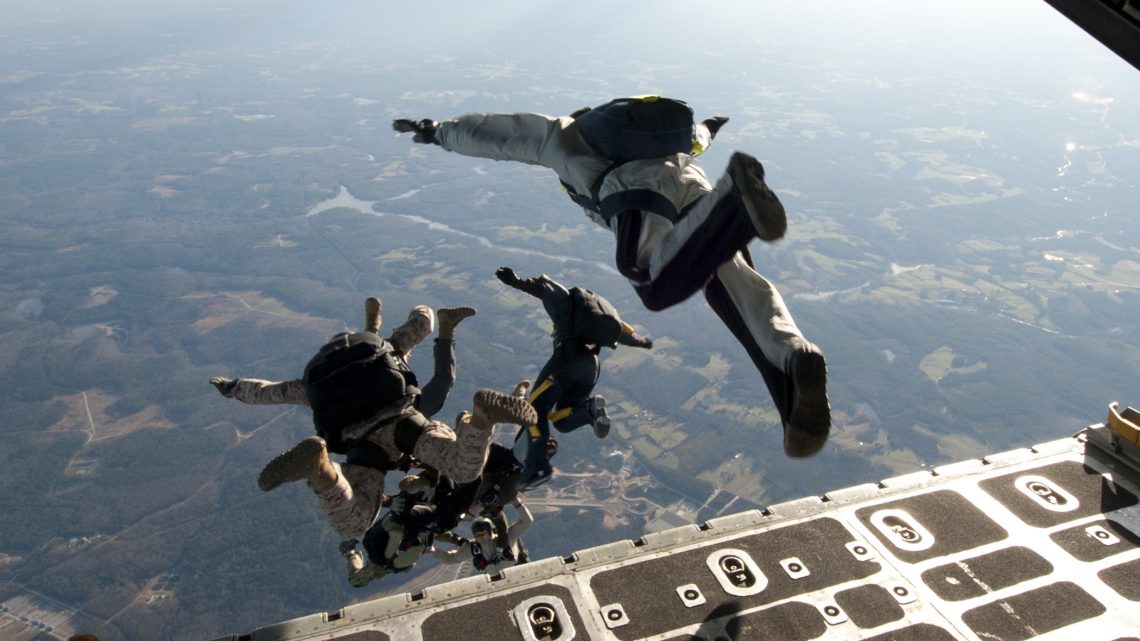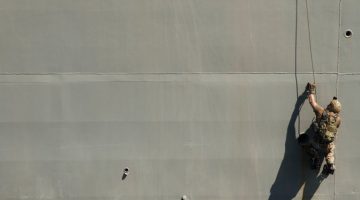(David Larter and Meghann Myers / Military Times) The Navy SEALs and other secretive units are quietly battling a frightening rise in parachute deaths
Navy SEAL Jason Kortz was 10,000 feet over Perris, California, about to perform his first a high-altitude, high-open jump while wearing night vision goggles and weighed down with bulky, cumbersome combat gear. America’s elite special operations troops conduct such training missions to prepare for the types of high-stakes, clandestine missions that have become a centerpiece of the U.S. military’s war on terrorism.
Tragically, this jump was also Kortz’s last.
As a student in the Navy’s Advanced Tactical Air Assault Course, Kortz had completed 32 prior free-fall jumps. But this training mission was much more complex — and it became a catastrophe almost the instant he exited the aircraft. Tumbling head over heels at speeds exceeding 100 mph, Kortz panicked. He was unable to arch his body and stabilize the fall, military investigators concluded.
He deployed his main parachute, but the uncontrolled fall caused it to tangle around his body. Kortz radioed the jumpmaster, who told him to cut his main chute and deploy the backup. When he did, it got tangled in the main chute and wrapped around his gear. Moments later, the third class special warfare operator was dead.
The Navy’s investigation, released to Military Times under the federal Freedom of Information Act, found troubling flaws in the SEALs’ jump-training programs. Officials determined Kortz was ordered to perform the complicated jump before he was ready, and that his death was “preventable.” Adm. Brian Losey, then the commander of Naval Special Warfare, ordered a thorough review of his command’s air operations.
But Kortz’s death on March 18, 2015, was far from an isolated incident. He was one of 11 special operators who died in such training accidents between 2011 and 2016, a 60 percent increase over the previous five-year period, according to 13 years worth of records obtained and analyzed by Military Times. (…)
This rise in training deaths alarmed senior leaders at U.S. Special Operations Command, which oversees the SEALs and each of the four military services’ most elite units. In September 2015, just two weeks after the investigation into Kortz’s death was completed, Army Gen. Joseph Votel, SOCOM’s commander at the time, quietly launched an intervention, halting all free-fall jumps for three months. Votel is now the head of U.S. Central Command.
Across Special Operations Command, his cessation order was vast and included several urgent steps to enhance safety measures, Military Times has learned. A SOCOM-wide review of all free-fall programs was conducted, focusing on procedures, doctrine and equipment. Additionally, all jumpmasters were retrained and sent back to their units to re-qualify all jumpers. The Military Freefall Working Group was established to review lessons learned from these episodes.
A SOCOM spokesman, Ken McGraw, expressed confidence that any shortcomings in the jump-training program have been identified and addressed.
But internally, SOCOM officials have struggled to identify a definitive cause behind the unsettling trend, and they have declined to discuss any lessons learned from the force-wide investigation. A Military Times review of accident investigations involving Army, Navy and Air Force special operations personnel revealed troubling training shortfalls, lapsed jump qualifications, and a number of accidents and deaths at least partially attributed to overconfidence on the part of the jumpers or the trainers. To that end, the spike in deaths has raised the question of whether there is a cultural problem inside some parts of Special Operations Command, and whether its fraternity of elite warriors fostered a complacency that undermined safety.
“Being ‘special’ shouldn’t be an excuse to cut corners or accept needless risk in either training or operations,” said one retired senior special operations officer whom Military Times asked to review the findings. The retired officer spoke on the condition of anonymity. “When the mission requires, you assess risk, carefully mitigate it and drive on. … That’s different than being improperly trained or careless. Attention to detail and adherence to safe operating procedures is even more fundamental to elite force operations than conventional units,” the operator said.
An Air Force Special Operations Command investigation into a 2015 midair collision between two special tactics airmen noted overconfidence on the part of one as a contributing factor in the tragedy. During the incident, which took place at Eglin Air Force Base in Florida, a group of nine airmen jumped at 10,000 feet, but one jumper descended too rapidly and caused the collision at 8,000 feet that killed both men. The airman “overestimated his personal capability to avoid other jumpers while descending rapidly to reach a lower jumper and substantially contributed to the mishap,” the investigation concludes.
Privately, SOCOM officials point to several factors that may help explain the spike in jump-training deaths. Since 9/11, the command has expanded dramatically. Today’s force of 70,000 elite soldiers, sailors, airmen and Marines is nearly double what it was in 2001. That means more operators who are doing jump training and, in turn, reporting more mishaps, officials said.
Others in the community have said special operations training is inherently dangerous, that accidents are unavoidable when preparing for the military’s most high-risk missions. “It’s not like a civilian skydive: You are strapping 100 pounds of crap to you and jumping out at 20,000 feet with oxygen,” said one enlisted service member who served with special operations forces and spoke on condition of anonymity. “There are all sorts of things that could happen to you. Your rucksack can become unclipped and destabilize you, your oxygen mask can get ripped off — we had one guy who that happened to, who passed out until he descended to a point where there was enough oxygen in the air for him to breathe. It’s no joke.”
NO COMMON THREADS
Since 2013, SEALs have lost four operators in jump training accidents. The Air Force has lost three operators over the past decade. The Marines lost three since 2009. The Army lost one Green Beret and one Ranger in the same time period.
Officials say there was no single factor attributed to the jump deaths, which varied in both type and service. Eight of the 11 SOCOM jump deaths since 2011 involved free falls —– with heavy combat gear — before the jumper opened his parachute. That includes high-altitude, high-open, or HAHO, jumps as well as the most dangerous jump: high-altitude, low-open, or HALO jumps, which are required for the most secretive missions. Three of the 11 jump deaths involved static-line jumps, in which the parachute opens immediately after leaving the plane.
A review of the Navy’s investigations found there was a range of reasons for the deaths. (…)
READ FULL ARTICLE >>> www.militarytimes.com
Photo Credit: Staff Sgt. Terrance Payton (as published in the same article)












